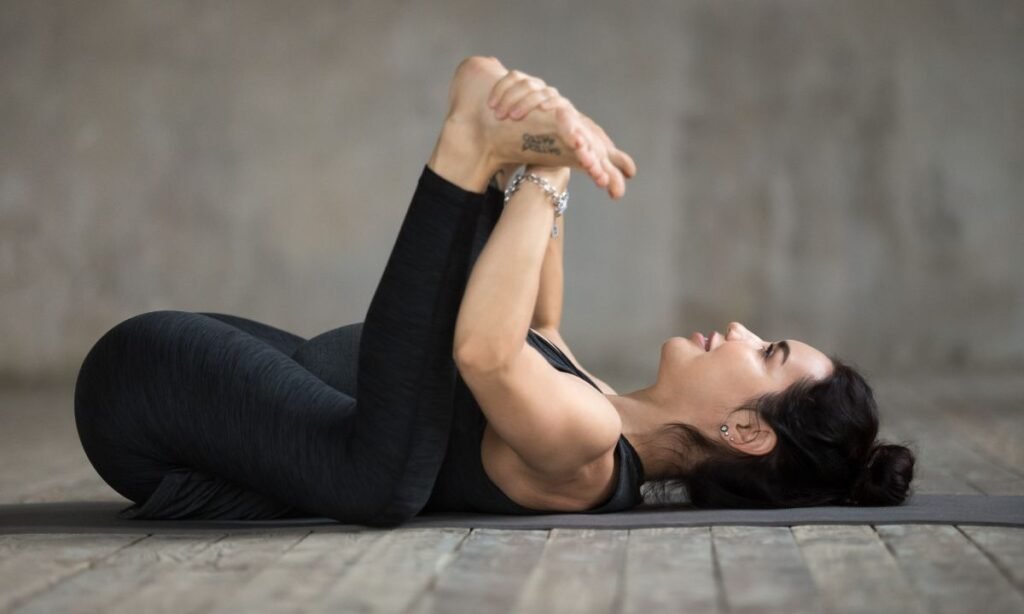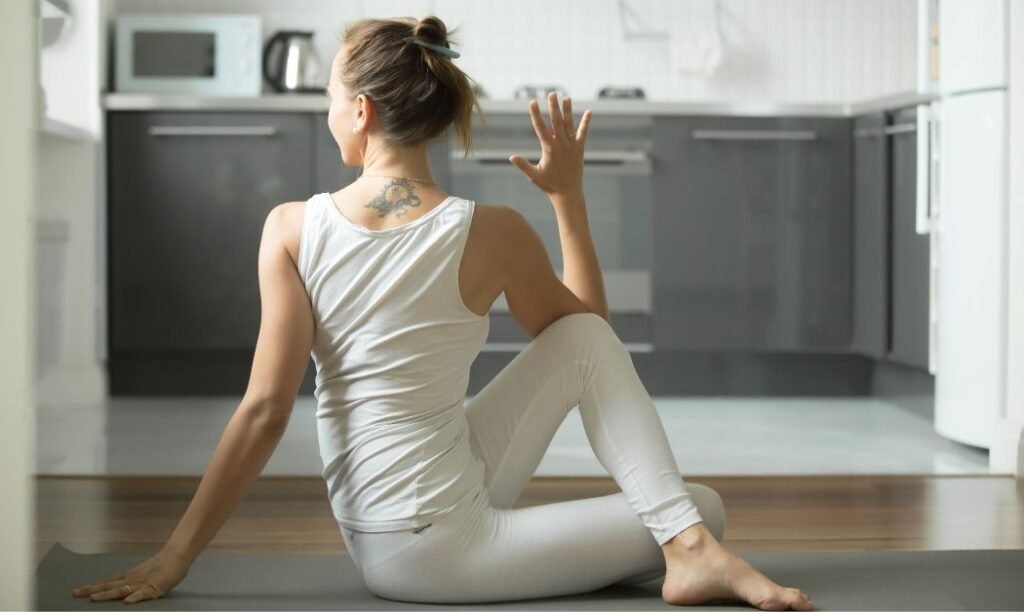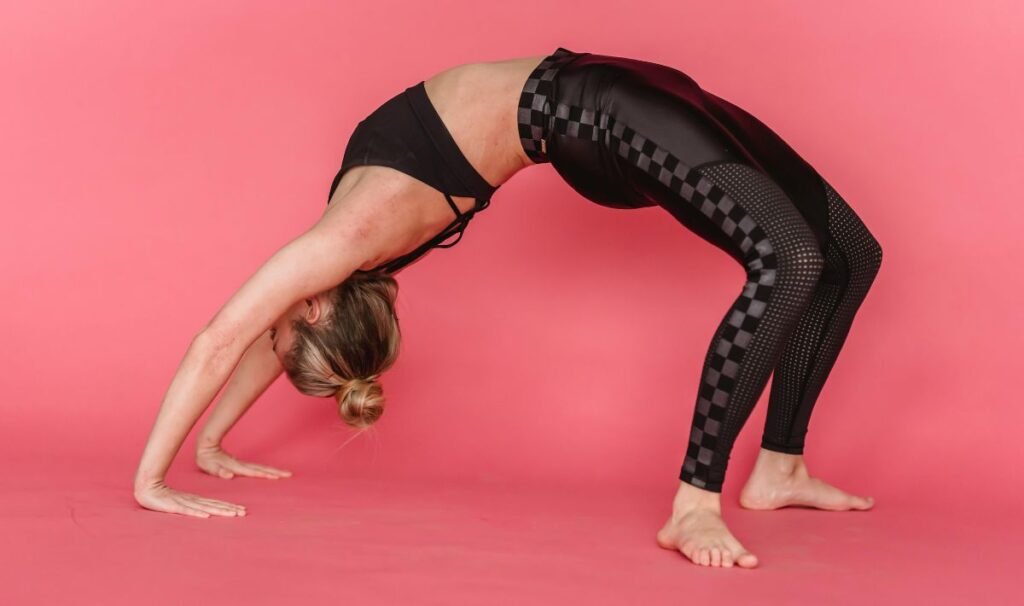Yoga is a practice that connects mind, body, and spirit through various postures, breathing exercises, and meditation. One of the most calming and joyful yoga poses is the Happy Baby Pose (Ananda Balasana). This pose not only stretches and relaxes the body but also provides a sense of serenity and peace. In this detailed guide, we will explore everything you need to know about Happy Baby Pose—how to do it, its benefits, and tips to enhance your yoga practice.
Introduction to Happy Baby Pose Yoga (Ananda Balasana)
The Happy Baby Pose (Ananda Balasana) is a gentle and restorative yoga pose that encourages deep relaxation and opens up your hips and lower back. The pose is aptly named because it resembles a baby lying on their back, playfully grabbing their feet. While it looks simple, Happy Baby Pose has numerous benefits for both physical and mental well-being.
In this blog post, we will walk you through how to perform Happy Baby Pose safely and effectively. We will also discuss its many benefits, from improving flexibility to promoting a state of calm, making it an ideal pose for both beginners and experienced practitioners.
What Is Happy Baby Pose?
Happy Baby Pose (Ananda Balasana) is a reclining pose commonly practiced in yoga sessions that focus on relaxation and release. The word “Ananda” in Sanskrit means bliss, while “Balasana” means child’s pose, emphasizing the lighthearted and comforting nature of the posture.
The pose primarily targets the hips, thighs, lower back, and groin muscles. It also involves a gentle spinal stretch, which can relieve tension in the lower back. Happy Baby Pose is known for being calming, and it’s often used toward the end of yoga sessions to ease the body into relaxation before savasana (corpse pose).
How to Do Happy Baby Pose
Happy Baby Pose is easy to perform, and it’s suitable for beginners. However, like all yoga poses, practicing it with proper alignment is essential for maximizing its benefits and avoiding strain or injury.
Steps to Perform Happy Baby Pose:
- Start by lying on your back: Find a comfortable space on your yoga mat and lie flat on your back. Take a moment to settle into the surface.
- Bend your knees toward your chest: Gently draw your knees up toward your armpits. Keep your back flat on the mat as you bend your knees deeply.
- Grab your feet: Reach up with both hands and hold onto the outer edges of your feet. Ensure your arms are positioned inside your legs. If you find it difficult to reach your feet, you can hold your ankles or shins instead.
- Gently pull down your feet: Use your hands to draw your feet down toward your chest, while keeping your knees wide. Your feet should point toward the ceiling.
- Keep your spine flat on the mat: Press your tailbone toward the ground to avoid arching your lower back. Your entire spine should feel connected to the mat.
- Relax your head and neck: Make sure your head and neck are relaxed, with your chin slightly tucked. Your gaze should be upward.
- Hold the pose for 30 seconds to 1 minute: Stay in this position, focusing on deep breathing. Inhale and exhale slowly, letting go of any tension in your hips or back.
Tip: If you feel strain in your neck, place a folded blanket or yoga block under your head for support.
Readmore: Master Standing Split Yoga Pose
Readmore: Mastering the Bird of Paradise Yoga Pose
Key Tips for Practicing Happy Baby Pose Safely
To ensure a safe and effective practice of Happy Baby Pose, here are a few key tips to keep in mind:
- Avoid Overstretching: While this pose involves a deep stretch in the hips and thighs, be mindful not to push your body too far. Listen to your body’s limits.
- Support Your Lower Back: Press your tailbone down to keep your lower back aligned with the mat. This helps prevent strain in your lumbar spine.
- Focus on Breathing: Inhale deeply to expand your lungs and exhale to relax your muscles further into the stretch. Controlled breathing enhances the benefits of this pose.
- Use Props: If you find it difficult to hold your feet, use a yoga strap to loop around your soles, helping you to maintain the stretch without straining.
Benefits of Happy Baby Pose
The Happy Baby Pose offers a wide range of physical, mental, and emotional benefits. Whether you’re looking to enhance flexibility, reduce tension, or boost your mood, this pose has something to offer.
Physical Benefits:
- Hip Opener: Happy Baby Pose is a deep hip-opening pose that helps release tightness in the hip flexors, inner thighs, and groin. It’s especially beneficial for those who sit for long periods.
- Lower Back Relief: By keeping the spine flat on the mat, the pose gently stretches and decompresses the lower back, helping to alleviate back pain and tension.
- Improves Flexibility: This pose enhances flexibility in the legs, hips, and lower back. Over time, regular practice can improve overall mobility.
- Aligns the Spine: Happy Baby Pose encourages a natural alignment of the spine, promoting better posture and spinal health.
- Stimulates Digestion: The gentle compression of the abdomen in this pose can stimulate digestion and relieve bloating.
Mental and Emotional Benefits:
- Promotes Calmness: By mimicking the playful, carefree actions of a baby, this pose helps release stress and anxiety, promoting a sense of relaxation.
- Reduces Mental Fatigue: Happy Baby Pose is often practiced toward the end of a yoga session to wind down, making it an excellent tool for reducing mental exhaustion.
- Boosts Mood: The joy of stretching and opening the body can bring about a sense of lightness and happiness, much like the innocence of a baby.
- Mind-Body Connection: The deep breathing involved in this pose helps improve mindfulness and enhances the connection between your body and mind.
Mistakes to Avoid
While Happy Baby Pose is relatively simple, some common mistakes can reduce its effectiveness or lead to discomfort. Here are a few pitfalls to watch out for:
- Arching the Lower Back: Avoid letting your lower back lift off the mat. This can strain your spine and take away from the benefits of the pose.
- Forcing the Stretch: Don’t force your knees too wide or pull your feet too hard. Yoga should be gentle and intuitive.
- Tensing the Neck: Keep your head and neck relaxed throughout the pose. If you feel tension, use a prop like a folded blanket for support.
- Shallow Breathing: Remember to breathe deeply and consistently. Holding your breath can cause tension and discomfort.
Readmore: Yoga by the Beach: Tips for an Energizing Experience
Readmore: How Yoga Can Help Improve Your Posture
Variations and Modifications
Happy Baby Pose can be adapted to suit different levels of flexibility and comfort. Whether you’re a beginner or an advanced practitioner, here are some variations and modifications you can try:
- Use a Strap: If you cannot reach your feet comfortably, loop a yoga strap around the soles of your feet and hold onto the ends. This will allow you to experience the stretch without strain.
- One-Legged Happy Baby Pose: If holding both feet feels too intense, you can practice a variation by holding only one foot while the other leg rests on the mat. Switch sides to balance the stretch.
- Rocking Baby Pose: For a gentle massage of your lower back, try rocking side to side while holding the pose. This adds a playful element and helps release tension in the spine.
How to Incorporate Happy Baby Pose into Your Routine
Happy Baby Pose can be included in your yoga practice in various ways:
- At the End of a Yoga Session: This pose is ideal for winding down after an intense yoga session. It helps relax the body before entering the final resting pose, savasana.
- As a Morning Stretch: Start your day by adding Happy Baby Pose to your morning stretch routine. It will help release stiffness in your hips and lower back after a night of sleep.
- Before Bedtime: Practicing this pose before bed can calm your mind and prepare your body for a restful night’s sleep.
- In Combination with Other Poses: Happy Baby Pose pairs well with other restorative poses like Child’s Pose (Balasana) and Reclining Bound Angle Pose (Supta Baddha Konasana).
Happy Baby Pose for Beginners
Happy Baby Pose is a beginner-friendly pose, but if you are new to yoga, here are a few tips to make it even more accessible:
- Start Slow: If you feel tightness in your hips or legs, begin with gentle stretches before attempting Happy Baby Pose. This will help loosen your muscles and prevent discomfort.
- Hold for Shorter Durations: As a beginner, you may find it challenging to hold the pose for extended periods. Start by holding it for 15-30 seconds and gradually increase the duration as your flexibility improves.
- Use Props for Support: If reaching your feet feels difficult, don’t hesitate to use props like yoga straps, blocks, or blankets for added support.
Conclusion
Happy Baby Pose (Ananda Balasana) is a beautiful yoga posture that combines physical stretch with emotional release. By opening the hips, stretching the lower back, and calming the mind, this pose offers a multitude of benefits that make it an essential part of any yoga practice. Whether you’re a beginner looking to explore yoga or an experienced yogi seeking relaxation, Happy Baby Pose can provide a joyful and restorative experience.
As you continue to practice this pose, remember to listen to your body, breathe deeply, and embrace the sense of ease and playfulness that comes with it. The more you connect with the pose, the more you will discover the blissful benefits it has to offer.
Readmore: Reverse Tabletop Pose Simplified
Readmore: Master the Half Pigeon Pose
FAQs
1. What is Happy Baby Pose (Ananda Balasana)?
Happy Baby Pose (Ananda Balasana) is a restorative yoga pose that involves lying on your back and holding your feet while gently pulling your knees toward your chest. This pose helps open the hips, stretch the lower back, and relax the body and mind.
2. What are the benefits of Happy Baby Pose?
The benefits of Happy Baby Pose include improved flexibility in the hips, groin, and lower back, relief from tension, better spinal alignment, reduced stress and anxiety, and enhanced mood. It also stimulates digestion and can promote relaxation before sleep.
3. How long should I hold Happy Baby Pose?
You can hold Happy Baby Pose for 30 seconds to 1 minute or longer, depending on your comfort level. Focus on deep, relaxed breathing throughout the pose for maximum benefit.
4. Can beginners do Happy Baby Pose?
Yes, Happy Baby Pose is beginner-friendly. It’s a gentle and simple pose that doesn’t require much flexibility. Modifications, such as using a yoga strap to hold your feet, can make it more accessible for beginners.
5. Is Happy Baby Pose safe during pregnancy?
While some people may practice Happy Baby Pose during pregnancy, it’s important to consult your healthcare provider or a prenatal yoga instructor before doing so. In general, lying flat on the back is not recommended in the later stages of pregnancy.

Sonu is a passionate yoga teacher with over 6+ years of experience helping individuals find balance, strength, and inner peace through the transformative power of yoga. As the creator of Pure Yoga Vibes, Sonu shares expert insights, inspiring practices, and a wealth of knowledge to support your wellness journey. Dedicated to creating a space for growth and mindfulness, Sonu’s mission is to make yoga accessible and enjoyable for everyone. For inquiries or collaborations, feel free to reach out at contact@pureyogavibes.com.



